Tropical storm (39–73 mph, 63–118 km/h)
Category 1 (74–95 mph, 119–153 km/h)
Category 2 (96–110 mph, 154–177 km/h)
Category 3 (111–129 mph, 178–208 km/h)
Category 4 (130–156 mph, 209–251 km/h)
Category 5 (≥157 mph, ≥252 km/h)
Unknown
On 19 October, the Fiji Meteorological Service reported that Tropical Disturbance 01F had developed out of an area of low pressure, about 1295 km (805 mi) to the northeast of Honiara in the Solomon Islands. [1] [2] At this time the system was located in an area favourable for further development, with warm sea-surface temperatures of 30–31 °C (86–88 °F) and low to moderate vertical windshear. [1] [3] Over the next couple of days, the system gradually developed further as it moved south-westwards towards the Santa Cruz Islands, before it was classified as a tropical depression by the FMS on 21 October. [4] Several hours later, the Joint Typhoon Warning Center (JTWC) issued a Tropical Cyclone Formation Alert (TCFA), after the system developed a partially exposed low-level circulation center. [5] Over the next couple of days, the system gradually moved southwestward before the FMS classified it as a tropical depression. [6] The convective structure improved considerably, and the JTWC initiated advisories on the system and classified it as Tropical Cyclone 01P at 21:00 UTC. [7] The cyclone drifted southward until an upper-level ridge forced the storm to the south. [8] The FMS subsequently named the system Lola at around 03:00 UTC on 22 October, after it had developed into a Category 1 tropical cyclone on the Australian tropical cyclone intensity scale. [9] [10]
Lola intensified into a Category 2 tropical cyclone twelve hours later, as fragmented banding that was wrapping broadly into the slowly consolidating central dense overcast (CDO). [11] [12] The JTWC upgraded Lola to a Category 1-equivalent cyclone on the Saffir–Simpson hurricane wind scale (SSHWS), with maximum one-sustained winds of 120 km/h (75 mph). [13] By early on 23 October, Lola had intensified into a Category 3 tropical cyclone, while the system's depiction showed that tightly wrapped convective banding was circulating around a ragged eye. [14] Lola rapidly intensified into a Category 4 intensity was reached by 12:00 UTC that day, with Lola exhibiting maximum ten-minute sustained winds of 175 km/h (110 mph). [15]
At 0000 UTC on 24 October, the JTWC reported that Lola had peaked with 1-minute sustained winds estimated at 230 km/h (145 mph), which made it equivalent to a category 4 tropical cyclone on the Saffir-Simpson hurricane wind scale. [16] At around the same time, the FMS estimated that Lola had peaked with 10-minute sustained winds of 215 km/h (130 mph), which made it a Category 5 severe tropical cyclone. [17] As a result, Lola become the earliest Category 5 tropical cyclone on record in the southern hemisphere. [18] [19] Lola's eye quickly disappeared, signaling a phase of rapid weakening. [20] Rapidly weakened due to vertical wind shear, Lola made landfall in Sowan, at around 03:00 UTC on 25 October. [21] The FMS and the JTWC reported that Lola's winds weakened to 100 km/h (65 mph), for the weakening system tracked over the Malakula. [22] [23] During 26 October, Lola degenerated into a tropical depression, before it was last noted the next day and the JTWC issued their final advisory on the storm. [24] [25]
Lola's remnants passed near New Caledonia's Loyalty Islands during 27 October, before they were last noted later that day, as they moved out of the FMS area of responsibility and into New Zealand's area of responsibility monitored by MetService. [26] [27]
Impact
Vanuatu

The National Disaster Management Office (NDMO), a disaster relief and rescue plan agency, was activated in six provinces and prepared to conduct an immediate assessment following the cyclone. All government buildings, markets, and banks are closed until further notice in the capital city of Port Vila. [28] On 23 October, the Vanuatu National Disaster Management Office (VNDMO) issued a yellow alert—indicating the threat of a tropical cyclone within 12 hours—for Penama and Sanma. The Vanuatu Meteorology and Geo-Hazards Department also issued a tropical cyclone warning for these areas. [29]
Vanuatu Prime Minister Charlot Salwai took a Royal Australian Air Force to inspect the early damage. Additionally, the New Zealand, Australian, and French defense forces will provide further aid and assess damages. [30] In Ambrym, two women, one of whom was pregnant, were reportedly killed. [31] Damage across the nation were estimated to be 43.28 billion vatu (US$352 million). [32]
Due to a communications breakdown on the islands, those reports were limited, but local officials told that homes, schools, and crops had been devastated by the central provinces of Penama and Malampa. [33] Pentecost, Malakula, and Ambrym have been most severely affected; It is estimated that 50% of all homes there have suffered damage. [31] UNICEF reported that Vanuatu requested support from the Union Civil Protection Mechanism (UCPM). The agency had emergency stockpiles in place across the country, including surveillance flight, shelter kits, tarpaulins. [34] On 30 October, New Zealand Foreign Minister Nanaia Mahuta announced that New Zealand would contribute NZ$450,000 in relief aid to Vanuatu; including NZ$350,000 to the Adventist Development and Relief Agency and NZ$100,000 to the Vanuatu government. [35]
Solomon Islands and New Zealand
The Solomon Islands National Disaster Management Office (NDMO) reported that Cyclone Lola had severe impacts on Tikopia. Lola caused four people, including a young child, to suffer injuries; 116 homes, and one church were destroyed. Additionally, the phone tower has been damaged. [36] The remnants of Cyclone Lola merged with a low-pressure system in the Tasman Sea before impacting northern areas of New Zealand on 30 October. [37] Severe weather caused flooding and power cuts across the upper North Island, while strong winds damaged power lines and led to cancelled flights. [38] A cruise ship bound for Auckland had to shelter near Rangitoto after the weather closed the port. [39]
Retirement
Due to extensive damages caused by the cyclone in Vanuatu and New Caledonia, Lola was retired by the World Meteorological Organisation on August 5, 2024. It was replaced with the name Lute [40]
See also
- Weather of 2023
- Tropical cyclones in 2023
- Cyclone Xavier (2006) - another strong cyclone which formed in a similar region and timeframe
- Cyclone Donna (2017) - another strong cyclone which became the strongest off-season storm in the region at the time
- Cyclones Judy and Kevin (2023) - Pair of strong South Pacific cyclones that had affected Vanuatu earlier that year
Related Research Articles

The 1997–98 South Pacific cyclone season was the most active South Pacific tropical cyclone season on record, with 16 tropical cyclones occurring within the South Pacific basin between 160°E and 120°W. The season started earlier than normal with 3 systems developing before the official start of the season on November 1, 1997, while the final system of the season dissipated on May 3, 1998, after the season had officially ended on April 30. During the season 50 people died as a result of tropical cyclones, with the deadliest being Cyclone Martin with 27 known deaths. The strongest tropical cyclones during the season were Cyclone Ron and Cyclone Susan as both were estimated to have minimum pressures of 900 hectopascals (26.6 inHg), and were the most intense tropical cyclones on record in the South Pacific Ocean until Cyclone Zoe in 2002–03. After the season ended, 11 names had their names either removed or retired from the lists of names, after they caused significant impacts to South Pacific islands.
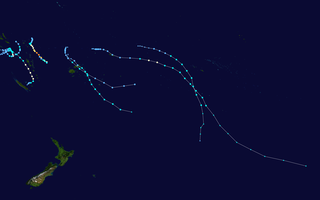
The 2006–07 South Pacific cyclone season was an event in the annual cycle of tropical cyclone formation. It began on November 1, 2006 and ended on April 30, 2007. These dates conventionally delimit the period of each year when most tropical cyclones form in the southern Pacific Ocean east of 160°E. Additionally, the regional tropical cyclone operational plan defines a tropical cyclone year separately from a tropical cyclone season, and the "tropical cyclone year" runs from July 1, 2006 to June 30, 2007.

Severe Tropical Cyclone Funa was the second strongest tropical cyclone during the 2007–08 South Pacific cyclone season, causing heavy flood and wind damage to areas of Vanuatu. The third tropical cyclone and second severe tropical cyclone of the season to form to the west of 160°E, Funa formed from an area of disturbed weather within the monsoon trough northeast of Vanuatu on January 16, 2008. Steadily intensifying as it moved to the east and subsequently south, Funa reached peak intensity with 10-minute sustained winds of 175 km/h (110 mph). However, the cyclone encountered unfavorable conditions as it progressed further south, before transitioning into an extratropical cyclone on January 21.

Severe Tropical Cyclone Xavier was a strong pre-season cyclone that formed on October 20, 2006 to the north of the Santa Cruz Islands. Cyclone Xavier was also the strongest storm of the season. During the next day it rapidly developed and was designated as Tropical Depression 01F later that day, before being designated as Tropical Cyclone Xavier while over Santa Cruz early on October 22. Later on October 22, Xavier intensified into a category 3 severe tropical cyclone on the Australian Tropical Cyclone Intensity Scale, before passing over Tikopia early the next day. Xavier then reached its peak wind speeds of 175 km/h, which made it a Category 4 cyclone early on October 24. Xavier stayed at its peak wind speeds until early the next day when it started to rapidly weaken, becoming a depression early on October 26. The remnants of Xavier persisted until October 28 before dissipating. There were no casualties reported as a result of the storm and little impact reported in the Solomon Islands and Vanuatu.
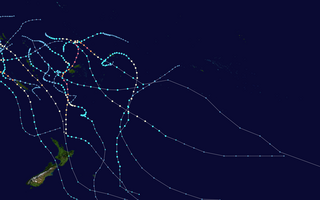
The 1996–97 South Pacific cyclone season was one of the most active and longest South Pacific tropical cyclone seasons on record, with 12 tropical cyclones occurring within the South Pacific basin between 160°E and 120°W. The season officially ran from November 1, 1996 - April 30, 1997, however, the season ended later than normal with three systems monitored after the official end of the season. The strongest tropical cyclone of the season was Cyclone Gavin which had a minimum pressure of 925 hPa (27.32 inHg). After the season had ended 4 tropical cyclone names were retired from the naming lists, after the cyclones had caused significant impacts to South Pacific islands.

The 1994–95 South Pacific cyclone season was one of the least active South Pacific tropical cyclone seasons on record, with only four tropical cyclones officially occurring within the South Pacific Ocean basin between 160°E and 120°W. The season ran from November 1, 1994, until April 30, 1995, with the first disturbance of the season developing on November 12 and the last disturbance leaving the base on March 5. The most intense tropical cyclone during the season was Tropical Cyclone Violet, which briefly existed within the basin. After the season, the name William was retired from the tropical cyclone naming lists.

The 1995–96 South Pacific cyclone season was a below average South Pacific tropical cyclone season's on record, with only five tropical cyclones occurring within the South Pacific Ocean to the east of 160°E. The season officially ran from November 1, 1995, until April 30, 1996. The first storm developed on January 12, while the last one dissipated on April 2. During the season the most intense tropical cyclone was Severe Tropical Cyclone Beti, which reached a minimum pressure of 935 hPa (27.61 inHg) as it affected New Caledonia. After the season ended Beti's name was the only name to be retired from the tropical cyclone naming lists and was replaced with Bune, after it inflicted over 5.6 million (USD) worth of damage to Australia, Vanuatu, New Caledonia and New Zealand.

Severe Tropical Cyclone Tia was the first of six tropical cyclones to affect Vanuatu during the 1991–92 South Pacific cyclone season. The system was first noted within the South Pacific convergence zone as a small tropical depression on November 13, to the northeast of the Solomon Islands. Over the next few days the system gradually developed further within an area of light winds in the upper troposphere, before it was named Tia early on November 16. Later that day due to a developing northerly steering current, the system slowed and undertook a small anticlockwise loop before starting to move towards the southwest and rapidly intensify. After rapidly intensifying throughout November 16 and 17, Tia passed within 55 km (35 mi) of the Solomon Island: Anuta at around 1800 UTC on November 17, before passing near Tikopia Island six hours later. As Tia moved near Tikopia, the system reached its peak intensity as a category 3 severe tropical cyclone, with 10‑minute sustained windspeeds of 140 km/h (85 mph).
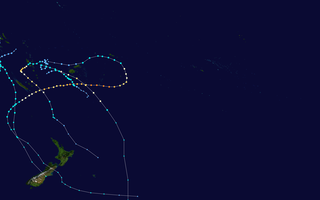
The 2017–18 South Pacific cyclone season was a slightly below-average season that produced 6 tropical cyclones, 3 of which became severe tropical cyclones. The season officially began on November 1, 2017, and ended on April 30, 2018; however, a tropical cyclone could have formed at any time between July 1, 2017, and June 30, 2018, and would count towards the season total. During the season, tropical cyclones were officially monitored by the Fiji Meteorological Service, MetService and the Australian Bureau of Meteorology, while the United States Joint Typhoon Warning Center (JTWC) also monitored the basin and issued warnings for American interests. The FMS attaches a number and an F suffix to significant tropical disturbances that form in or move into the basin, while the JTWC designates significant tropical cyclones with a number and a P suffix. The BoM, FMS and MetService all use the Australian Tropical Cyclone Intensity Scale and estimate wind speeds over a period of ten minutes, while the JTWC estimates sustained winds over a 1-minute period, which are subsequently compared to the Saffir–Simpson hurricane wind scale (SSHWS).

The 2019–20 South Pacific cyclone season was a slightly above-average season in which tropical cyclones formed within the South Pacific Ocean to the east of 160°E. The season officially ran from November 1, 2019, to April 30, 2020, however a tropical cyclone could form at any time between July 1, 2019, and June 30, 2020, and would count towards the season total. The season began on November 22 with the formation of Tropical Cyclone Rita, which would later become a severe tropical cyclone. The season has been near-average in terms of activity, with 8 tropical cyclones and 4 severe tropical cyclones forming during the season. The season featured Cyclone Harold, the first Category 5 severe tropical cyclone in the basin since Cyclone Gita, and one of the strongest since Cyclone Winston. During the season, tropical cyclones are officially monitored by the Fiji Meteorological Service (FMS), Australian Bureau of Meteorology (BOM) and New Zealand's MetService. The United States Armed Forces through the Joint Typhoon Warning Center (JTWC) also monitors the basin and issue unofficial warnings for American interests. The FMS attaches a number and an F suffix to tropical disturbances that form in or move into the basin while the JTWC designates significant tropical cyclones with a number and a P suffix. The FMS, BoM and MetService all use the Australian Tropical Cyclone Intensity Scale and estimate wind speeds over a period of ten minutes, while the JTWC estimated sustained winds over a 1-minute period, which are subsequently compared to the Saffir–Simpson hurricane wind scale (SSHWS).
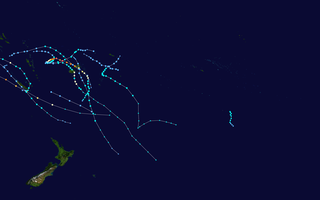
The 2020–21 South Pacific cyclone season was an average season where most tropical cyclones formed within the South Pacific Ocean to the east of 160°E. The season officially started on November 1, 2020, and officially ended on April 30, 2021, however a tropical cyclone could form at any time between July 1, 2020, and June 30, 2021, and would count towards the season total. During the season, tropical cyclones will be officially monitored by the Fiji Meteorological Service (FMS), Australian Bureau of Meteorology (BoM), New Zealand's MetService. The United States Armed Forces through the Joint Typhoon Warning Center (JTWC) will also monitor the basin and issue unofficial warnings for American interests. RSMC Nadi attaches a number and an F suffix to tropical disturbances that form in or move into the basin while the JTWC designates significant tropical cyclones with a number and a P suffix. RSMC Nadi, TCWC Wellington and TCWC Brisbane all use the Australian Tropical Cyclone Intensity Scale and estimate windspeeds over a period of ten minutes, while the JTWC estimated sustained winds over a 1-minute period, which are subsequently compared to the Saffir–Simpson hurricane wind scale (SSHWS).

Severe Tropical Cyclone Eric was one of two tropical cyclones to affect the island nations of Vanuatu and Fiji within a week during January 1985. The precursor shallow depression developed within the monsoon trough during 13 January, to the west of Espiritu Santo, Vanuatu. On 16 January, the storm developed-hurricane-force winds and Eric began to undergo rapid deepening. While two different agencies differ on when and how strong Eric was at its peak, it was believed to have peaked on 17 January while passing through the Fiji island group. Shortly after its peak, Eric began to weaken steadily, and by 20 January, Severe Tropical Cyclone Eric had ceased to exist as a tropical cyclone. Combined with another storm – Cyclone Nigel – Eric caused 25 fatalities and $40 million worth of damage. A total of 299 farms were affected as well as the airport in Nadi. About 30,000 people were left homeless. Severe crop damage was also reported. Viti Levu sustained the worst effects from Cyclone Eric. During the aftermath of the storm, a number of first world countries distributed aid for victims of Eric.
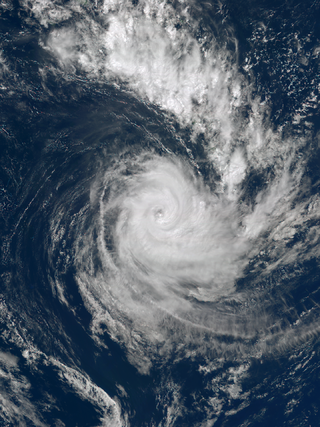
Severe Tropical Cyclone Cook was the second named tropical cyclone of the 2016–17 South Pacific cyclone season.

Severe Tropical Cyclone Donna was the strongest off-season tropical cyclone in the Southern Hemisphere at the time, since surpassed by Cyclone Lola in 2023. The twenty-first tropical disturbance, third named storm, and second severe tropical cyclone of the annual cyclone season, Donna formed from an area of disturbed weather that was first monitored west-northwest of Fiji on 1 May 2017. The disturbance drifted eastward amid an increasingly favourable environment, and it was designated Tropical Depression 21F late on 2 May. Twelve hours later, it intensified into a Category 1 on the Australian tropical cyclone scale and was designated Tropical Cyclone Donna as the storm's motion shifted west and then south. After reaching its initial peak as a Category 4 cyclone early on 6 May, the effects of wind shear and upwelling caused the storm to weaken. However, it reintensified into a Category 5 cyclone on 8 May. Soon after, Donna entered a region of strong westerly flow and began to rapidly weaken. Continuing to accelerate in a southerly direction, Donna eventually weakened into a tropical low on 10 May. By 16 May, Donna's remnants had fully dissipated.

The 2021–22 South Pacific cyclone season was a near average tropical cyclone season within the South Pacific Ocean to the east of 160°E. The season officially started from November 1, 2021, and officially ended on April 30, 2022, however a tropical cyclone could form at any time between July 1, 2021, and June 30, 2022, and would count towards the season total. During the season, tropical cyclones will be officially monitored by the Fiji Meteorological Service, Australian Bureau of Meteorology and New Zealand's MetService. The United States Armed Forces through the Joint Typhoon Warning Center (JTWC) will also monitor the basin and issue unofficial warnings for American interests. The FMS attaches a number and an F suffix to tropical disturbances that form in or move into the basin while the JTWC designates significant tropical cyclones with a number and a P suffix. The BoM, FMS and MetService all use the Australian Tropical Cyclone Intensity Scale and estimate windspeeds over a period of ten minutes, while the JTWC estimated sustained winds over a 1-minute period, which are subsequently compared to the Saffir–Simpson hurricane wind scale (SSHWS).

Severe Tropical Cyclone Cody was a strong tropical cyclone in the South Pacific which caused widespread damage in Fiji. The second tropical cyclone and first severe tropical cyclone of the 2021–22 South Pacific cyclone season, Cody was first noted by the Fiji Meteorological Service (FMS) on 5 January as Tropical Disturbance 03F. The tropical depression killed one person, and over 4,500 people were evacuated. On 10 January, the system was upgraded to a Category 1 tropical cyclone by the FMS, receiving the name Cody. While the FMS recorded a peak intensity of 130 km/h (80 mph), the Joint Typhoon Warning Center (JTWC) only recorded a peak intensity of 95 km/h (60 mph). Cody was the first tropical cyclone in 2022.

During 2023, tropical cyclones formed in seven major bodies of water, commonly known as tropical cyclone basins. They were named by various weather agencies when they attained maximum sustained winds of 35 knots. Throughout the year, a total of 115 systems formed, with 79 of them being named. The most intense storm this year was Typhoon Mawar, which had a minimum pressure of 900 hPa (26.58 inHg). The deadliest tropical cyclone of the year was Storm Daniel, which killed at least 5,591 people in Libya, Greece, Turkey, and Bulgaria. Meanwhile, the costliest tropical cyclone was Typhoon Doksuri which caused at least $28.4 billion (USD) worth of damage in China, the Philippines and Taiwan, becoming the costliest on record outside the Atlantic Ocean basin. Among this year's systems, thirty became major tropical cyclones, of which nine intensified into Category 5 tropical cyclones on the Saffir–Simpson scale (SSHWS), the most since 2018. The accumulated cyclone energy (ACE) index for the 2023, as calculated by Colorado State University (CSU) was 857.4 units, which was above the 1991–2020 mean of 770.2 units.
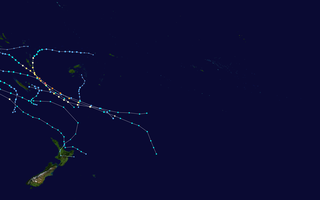
The 2022–23 South Pacific cyclone season was a below-average but very destructive tropical cyclone season that featured one of the costliest tropical cyclones in the Southern Hemisphere on record. The season officially started on November 1, 2022, and ended April 30, 2023; however, a tropical cyclone could form at any time between July 1, 2022, and June 30, 2023, and would count towards the season total. During the season, tropical cyclones were officially monitored by the Fiji Meteorological Service (FMS), Australian Bureau of Meteorology (BOM) and New Zealand's MetService. The United States Armed Forces through the Joint Typhoon Warning Center (JTWC) also monitored the basin, issuing unofficial warnings for American interests. The FMS attaches a number and an F suffix to tropical disturbances that form in or move into the basin while the JTWC designates significant tropical cyclones with a number and a P suffix. The BoM, FMS and MetService all use the Australian Tropical Cyclone Intensity Scale and estimate windspeeds with a period of approximately ten minutes, while the JTWC estimates sustained winds over a 1-minute period, which are subsequently compared to the Saffir–Simpson hurricane wind scale (SSHWS).

Severe Tropical Cyclones Judy and Kevin were a pair of intense tropical cyclones that made landfall on the Pacific island nation of Vanuatu within 48 hours of each other in March 2023. They were the fourth and fifth named storms of the 2022–23 South Pacific cyclone season respectively, as well as the second and third severe tropical cyclones of the season. By the end of February, Judy had affected the Solomon Islands, and shortly after, Kevin began to affect the country.

The 2023–24 South Pacific cyclone season was a below-average season within the South Pacific Ocean to the east of 160°E. The season officially started on November 1, 2023, and ended on April 30, 2024, however a tropical cyclone could form between July 1, 2023, and June 30, 2024, and still be included in the season, as shown by Cyclone Lola which formed in October. During the season, tropical cyclones will be officially monitored by the Fiji Meteorological Service, Australian Bureau of Meteorology and New Zealand's MetService. The United States Armed Forces through the Joint Typhoon Warning Center (JTWC) will also monitor the basin and issue unofficial warnings for American interests. The FMS attaches a number and an F suffix to systems that are active in the basin while the JTWC designates significant tropical cyclones with a number and a P suffix. The BoM, FMS and MetService all use the Australian Tropical Cyclone Intensity Scale and estimate winds with a 10-minute period, while the JTWC estimates winds over a 1-minute period, which are subsequently compared to the Saffir–Simpson hurricane wind scale (SSHWS).
References
- 1 2 Tropical Disturbance Summary October 19, 2023 08z (Report). Fiji Meteorological Service. 19 October 2023. Archived from the original on 26 October 2023. Retrieved 19 October 2023.
- ↑ "Off season tropical disturbance monitored in the region" (PDF) (Press release). Fiji Meteorological Service. 20 October 2023. Archived from the original (PDF) on 23 October 2023. Retrieved 23 October 2023.
- ↑ Significant Tropical Weather Advisory for the Western and South Pacific Oceans October 20, 2023 00z (Report). United States Joint Typhoon Warning Center. 21 October 2023. Archived from the original on 23 October 2023. Retrieved 21 October 2023.
- ↑ Tropical Depression Advisory October 21, 2023 18z (Report). Fiji Meteorological Service. 21 October 2023. Archived from the original on 21 October 2023. Retrieved 25 October 2023.
- ↑ Tropical Cyclone Formation Alert (Invest 90P) (Report). United States Joint Typhoon Warning Center. 21 October 2023. Archived from the original on 21 October 2023. Retrieved 21 October 2023.
- ↑ Tropical Depression 01F Advisory Number A5 (Report). Fiji Meteorological Service. 21 October 2023. Archived from the original on 21 October 2023. Retrieved 21 October 2023.
- ↑ Prognostic Reasoning for Tropical Cyclone 01P (One) Warning No. 1 (Report). United States Joint Typhoon Warning Center. 21 October 2023. Archived from the original on 21 October 2023. Retrieved 21 October 2023.
- ↑ Tropical Depression 01F Advisory Number A6 (Report). Fiji Meteorological Service. 22 October 2023. Archived from the original on 22 October 2023. Retrieved 22 October 2023.
- ↑ Tropical Cyclone Naming Bulletin October 22, 2023 06z (Report). Fiji Meteorological Service. 22 October 2023. Archived from the original on 22 October 2023. Retrieved 24 October 2023.
- ↑ Tropical Cyclone Lola Storm Warning Number 06 (Report). Fiji Meteorological Service. 22 October 2023. Archived from the original on 22 October 2023. Retrieved 22 October 2023.
- ↑ Prognostic Reasoning for Tropical Cyclone 01P (Lola) Warning No. 4 (Report). United States Joint Typhoon Warning Center. 22 October 2023. Archived from the original on 22 October 2023. Retrieved 22 October 2023.
- ↑ Tropical Cyclone Lola Hurricane Warning Number 07 (Report). Fiji Meteorological Service. 22 October 2023. Archived from the original on 22 October 2023. Retrieved 22 October 2023.
- ↑ Prognostic Reasoning for Tropical Cyclone 01P (Lola) Warning No. 5 (Report). United States Joint Typhoon Warning Center. 22 October 2023. Archived from the original on 22 October 2023. Retrieved 22 October 2023.
- ↑ Severe Tropical Cyclone Lola Hurricane Warning Number 09 (Report). Fiji Meteorological Service. 23 October 2023. Archived from the original on 23 October 2023. Retrieved 23 October 2023.
- ↑ Severe Tropical Cyclone Lola Hurricane Warning Number 11 (Report). Fiji Meteorological Service. 23 October 2023. Archived from the original on 23 October 2023. Retrieved 23 October 2023.
- ↑ https://www.nrlmry.navy.mil//tcdat/tc2024/SH/SH012024/txt/trackfile.txt
- ↑ Tropical Disturbance Advisory October 24, 2023 0145 UTC (Report). Fiji Meteorological Service. 24 October 2023. Archived from the original on 26 October 2023. Retrieved 26 October 2023.
- ↑ "Strengthening Tropical Cyclone Lola sets southern hemisphere record". www.9news.com.au. 24 October 2023. Archived from the original on 24 October 2023. Retrieved 24 October 2023.
- ↑ Data, New Zealand's Weather; Authority, Alerts. "VANUATU: TC-LOLA remains a major Category 5 storm as it moves into Vanuatu, may weaken a little (Maps + Animations)". WeatherWatch.co.nz. Archived from the original on 24 October 2023. Retrieved 24 October 2023.
- ↑ Prognostic Reasoning for Tropical Cyclone 01P (Lola) Warning No. 11 (Report). United States Joint Typhoon Warning Center. 24 October 2023. Archived from the original on 24 October 2023. Retrieved 24 October 2023.
- ↑ Prognostic Reasoning for Tropical Cyclone 01P (Lola) Warning No. 14 (Report). United States Joint Typhoon Warning Center. 25 October 2023. Retrieved 25 October 2023.
- ↑ Tropical Cyclone Lola Storm Warning Number 15 (Report). Fiji Meteorological Service. 25 October 2023. Archived from the original on 25 October 2023. Retrieved 25 October 2023.
- ↑ Prognostic Reasoning for Tropical Cyclone 01P (Lola) Warning No. 16 (Report). United States Joint Typhoon Warning Center. 25 October 2023. Archived from the original on 25 October 2023. Retrieved 25 October 2023.
- ↑ Tropical Disturbance Summary October 26, 2023 0105 UTC (Report). Fiji Meteorological Service. 26 October 2023. Archived from the original on 26 October 2023. Retrieved 26 October 2023.
- ↑ Tropical Cyclone 01P (Lola) Warning No. 18 (Report). United States Joint Typhoon Warning Center. 26 October 2023. Archived from the original on 26 October 2023. Retrieved 26 October 2023.
- ↑ Tropical Disturbance Summary October 27, 2023 07z (Report). Fiji Meteorological Service. 27 October 2023. Archived from the original on 28 October 2023. Retrieved 28 October 2023.
- ↑ Marine Weather Bulletin for Islands Area October 27, 2023 18z (Report). Fiji Meteorological Service. 27 October 2023.
- ↑ RNZ (24 October 2023). "Tropical Cyclone Lola: Vanuatu on high alert as storm approaches eastern island". Stuff. Archived from the original on 25 October 2023. Retrieved 28 October 2023.
- ↑ "Category 2 cyclone Lola: Warnings in Vanuatu". RNZ . 23 October 2023. Archived from the original on 24 October 2023. Retrieved 22 October 2023.
- ↑ "Vanuatu Prime Minister Charlot Salwai surveys Cyclone Lola damage from the air". RNZ . 26 October 2023. Archived from the original on 26 October 2023. Retrieved 28 October 2023.
- 1 2 "Pacific.scoop.co.nz » 'It's Just How Life Is Here': Children In Vanuatu Devastated By Early Return Of Cyclone Season". Archived from the original on 27 October 2023. Retrieved 28 October 2023.
- ↑ "TC Lola National Recovery Plan". Department of Strategic Policy, Planning & Aid Coordination. 20 May 2024. Archived from the original on 20 May 2024. Retrieved 3 November 2024.
- ↑ "Cyclone Lola leaves behind 'major' damage in Vanuatu in the South Pacific". Yahoo News. 26 October 2023. Archived from the original on 28 October 2023. Retrieved 28 October 2023.
- ↑ "Vanuatu, New Caledonia (France) - Tropical Cyclone LOLA, update (DG ECHO, GDACS, IFRC, media, Copernicus EMSR) (ECHO Daily Flash of 27 October 2023) - Vanuatu | ReliefWeb". reliefweb.int. 27 October 2023. Archived from the original on 28 October 2023. Retrieved 28 October 2023.
- ↑ "NZ Government announces $450,000 aid for Vanuatu after ex-Tropical Cyclone Lola". Radio New Zealand . 30 October 2023. Archived from the original on 30 October 2023. Retrieved 31 October 2023.
- ↑ "Cyclone Lola batters remote Tikopia in Solomon Islands - disaster office confirms". RNZ . 27 October 2023. Archived from the original on 27 October 2023. Retrieved 28 October 2023.
- ↑ "Rain, swells and wind as Cyclone Lola remnants merge with low". 1 News. Retrieved 1 November 2023.
- ↑ "Power cuts as ex-cyclone Lola lashes upper North Island". RNZ . 30 October 2023. Retrieved 1 November 2023.
- ↑ "Cruise ship bound for Auckland sheltering near Rangitoto as ex-Tropical Cyclone Lola closes port". Newshub. Archived from the original on 1 November 2023. Retrieved 1 November 2023.
- ↑ Noble, Chris (5 August 2024). "🌀Due to the severe impacts of tropical cyclones in the 2023-24 Season, Members at the 22nd session of the @WMO RA V Tropical Cyclone Committee agreed to retire 5 names: Lola, Mal, Jasper, Kirrily and Megan ✅An updated Operational Plan will be published before the 2024-25 Season". X (Formerly Twitter). Retrieved 14 October 2024.
External links
 Lola at its peak intensity off Vanuatu on 24 October |
Tropical cyclones of the 2023–24 South Pacific cyclone season | ||
|---|---|---|
